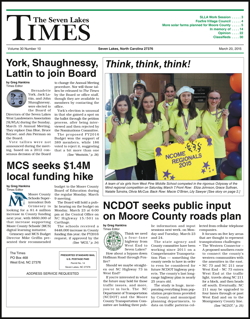At 8:35 am on a typical weekday, Seven Lakes Drive is quiet — and this day was no different.
“I never saw it coming,” said Northsider Kurt Kreuger. “The first thing I realized was that I was airborne, and I was going sideways on my bike.”
 A retired firefighter and an avid long-distance cyclist, Kreuger is conscientious about safety. To the point of being annoyingly hyper-conscious, his wife, Barbara Keating, will argue.
A retired firefighter and an avid long-distance cyclist, Kreuger is conscientious about safety. To the point of being annoyingly hyper-conscious, his wife, Barbara Keating, will argue.
His jersey was brightly-colored, he was wearing a helmet and riding as far right on the travel lane as possible, and he had specifically chosen that time of day — after the morning school buses and office commuters have headed out — for his thrice-per-week, 30-mile training rides to Carthage and back.
The sun was shining, traffic was light, and the “it” he never saw coming was a passing motor vehicle.
Kreuger is grateful for what didn’t happen.
“I was lucky,” he told The Times. “It was a glancing blow, and the fortunate part is that I landed in an area that was moist and soft soil. If it had been rocky, or if I had been hit just a bit more centered, I would have been in worse shape.”
Despite his positive outlook, the fact is that the impact was violent enough to wedge the passing motor vehicle’s mirror into the frame of Kreuger’s bike and to permanently weld shut the buckle clips on his specialty biking shoes. Medical tests are still underway as doctors continue to treat damage to his hip and knee.
And his days of solo biking along lonely stretches of rural roadways are also over — a personal favor for his wife.
“From now on, I’ll be driving my bike over to Southern Pines a few times a week to participate in a group ride,” explained Kreuger.
“When you ride with ten or fifteen riders, even a driver who isn’t paying close attention won’t overlook you. Your visibility is greatly enhanced.”
 Water.
Water. Identifying the need for and basic objectives of a new policy are the easy part; nailing down the precise language to accomplish that goal often proves to be more difficult.
Identifying the need for and basic objectives of a new policy are the easy part; nailing down the precise language to accomplish that goal often proves to be more difficult. With four teachers on staff — including new director Abbie Locklear — daily programming at Cyber Ed includes a strong emphasis on early learning.
With four teachers on staff — including new director Abbie Locklear — daily programming at Cyber Ed includes a strong emphasis on early learning. A certified Art Clay instructor, owner Karen Simmons-Milligan will open her doors to the public on Saturday, October 1, to share the fun and exciting process of taking a piece of silver clay and making it into a one-of-a-kind piece of silver jewelry.
A certified Art Clay instructor, owner Karen Simmons-Milligan will open her doors to the public on Saturday, October 1, to share the fun and exciting process of taking a piece of silver clay and making it into a one-of-a-kind piece of silver jewelry. A retired firefighter and an avid long-distance cyclist, Kreuger is conscientious about safety. To the point of being annoyingly hyper-conscious, his wife, Barbara Keating, will argue.
A retired firefighter and an avid long-distance cyclist, Kreuger is conscientious about safety. To the point of being annoyingly hyper-conscious, his wife, Barbara Keating, will argue.